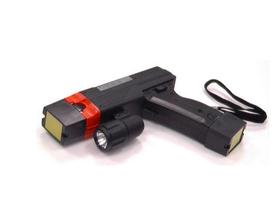|
 |

An electroshock weapon is an incapacitant weapon used for incapacitating a person by administering electric shock aimed at disrupting superficial muscle functions and/or causing pain without significantly hurting the subject.
Multiple types of these devices exist differing by the mode of use. Stun guns, batons (or prods), and belts administer an electric shock by direct contact, whereas Tasers (conducted electrical weapons, CEW) fire projectiles that administer the shock through thin flexible wires. Long-range electroshock projectiles, which can be fired from ordinary shotguns and do not need the wires, have been developed as well.
Electroshock weapon technology uses a temporary high-voltage, low-current electrical discharge to override the body's muscle-triggering mechanisms. Commonly referred to as a stun gun, electroshock weapons are a relative of cattle prods, which have been around for over 100 years and are the precursor of stun guns. The recipient is immobilized via two metal probes connected via wires to the electroshock device. The recipient feels pain, and can be momentarily paralyzed while an electric current is being applied. Essential to the operation of electroshock, stun guns and cattle prods is sufficient amperage to allow the weapon to stun. Without amperage these weapons cannot stun and the degree to which the weapon is capable of stunning depends on its proper use of amperage. It is reported that applying electroshock devices to more sensitive parts of the body is even more painful. The maximum effective areas for stun gun usage are upper shoulder, below the rib cage, and the upper hip. High voltages are used, but because most devices use a non-lethal current, death does not usually occur. The resulting "shock" is caused by muscles twitching uncontrollably, appearing as muscle spasms.
The internal circuits of most electroshock weapons are fairly simple, based on either an oscillator, resonant circuit (a power inverter), and step-up transformer or adiode-capacitor voltage multiplier to achieve an alternating high-voltage discharge or a continuous direct-current discharge. It may be powered by one or more batteriesdepending on manufacturer and model. The amount of amperage generated depends on what stunning capabilities are desired, but without proper amperage calculations, the cause and effect of high voltage is muted. Output voltage is claimed to be in the range of 100 V up to 6 KV; current intensity output is claimed to be in the range of 100 to 500 mA; individual impulse duration is claimed to be in the range of 10 to 100 μs (microseconds); frequency of impulse is claimed to be in the range of 2 to 40 Hz; electrical charge delivered is claimed to be in the range of 15 to 500 μC (micro-Coulomb); energy delivered is claimed to be in the range of 0.9 to 10 J. The outputcurrent upon contact with the target will depend on various factors such as target's resistance, skin type, moisture, bodily salinity, clothing, the electroshock weapon's internal circuitry, discharge waveform, and battery conditions.
Manufacturers' instructions and manuals shipped with the products state that a half-second shock duration will cause intense pain and muscle contractions, startling most people greatly. Two to three seconds will often cause the recipient to become dazed and drop to the ground, and over three seconds will usually completely disorient and drop the recipient for at least several seconds. TASER International warns law enforcement agencies that "prolonged or continuous exposure(s) to the TASER device’s electrical charge" may lead to medical risks such as cumulative exhaustion and breathing impairment.
Because there was no automatic stop on older model Taser guns, many officers have used it repeatedly or for a prolonged period of time, thus potentially contributing to suspects’ injuries or death. The current X26 model automatically stops five seconds after the trigger is depressed and then the trigger must be depressed again to send another "shock". The trigger can be held down continuously for a longer shock or the device can be switched off before the full five seconds have elapsed.